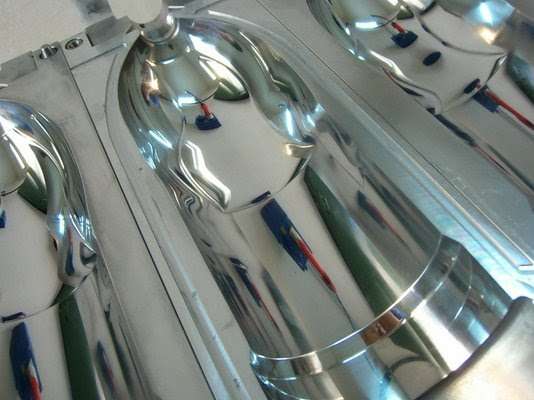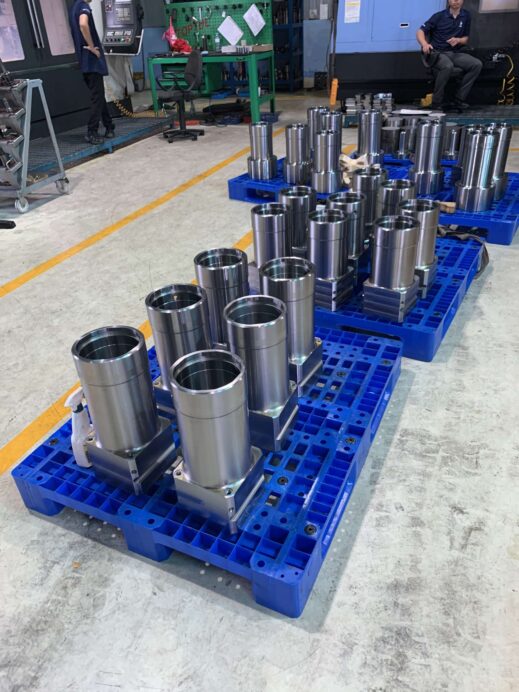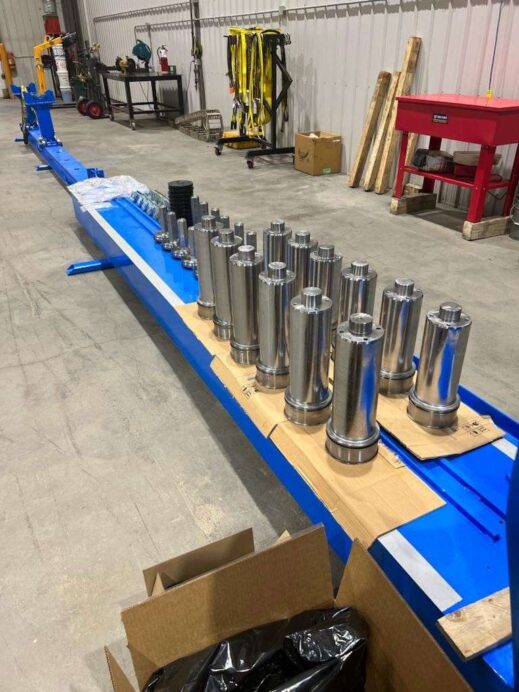Hard chrome Plating Standard AMS 2460
Hard Chrome at Sai Gon Hydraulic Company, implementing Chromium coatings according to standardized processes from various countries around the world.

Hard Chromium Plating, also known as Hard Chrome Plating, is an electroplating process in which a layer of chromium is applied to the surface of metal components to provide durable, wear-resistant, and corrosion-resistant surface properties. Standards for the hard chromium plating process are typically established by standardization organizations and industries to ensure quality and meet specific requirements.
There are several popular standards used for hard chromium plating, including:
ASTM B650 Hard chrome plating
This standard by the American Society for Testing and Materials (ASTM) specifies the requirements for hard chromium plating on metal and alloy surfaces.

AMS 2460 Hard chrome plating
The Aerospace Material Specification (AMS) 2460, issued by the Society of Automotive Engineers (SAE), covers hard chromium plating on aerospace components.
ISO 1456 Hard chrome plating
This international standard by the International Organization for Standardization (ISO) deals with metallic coatings for corrosion protection.
The hard chromium plating process involves multiple steps, such as surface cleaning, pre-nickel plating to enhance adhesion, and then the actual hard chromium plating. The thickness of the hard chromium layer typically ranges from a few micrometers to several tens of micrometers, depending on the specific application and standard requirements.
The resulting hard chromium coating provides excellent surface properties, including resistance to wear, corrosion, impact, and chemical resistance. It is commonly used in industries that demand high durability and precision in mechanical components, automotive parts, aerospace components, and other critical industrial applications.

MIL-C-23422 Hard chrome plating
Mil-c-23422 is a military specification that was used for hard chromium plating on various metal and alloy surfaces. However, it’s important to note that the MIL-C-23422 specification has been canceled, and it is no longer an active standard.
Military specifications like MIL-C-23422 are used by the U.S. military to define specific requirements and quality standards for various materials, processes, and products used in military applications. These specifications help ensure that the materials and processes used meet the necessary performance and safety requirements.
Since MIL-C-23422 is no longer in use, it has been replaced or superseded by other standards or specifications. It is essential to refer to the latest and applicable standards in the aerospace and military industries to ensure compliance with current requirements for hard chromium plating and other processes.

SAE AMS-QQ-C-320 Hard chrome plating
is an aerospace material specification issued by the Society of Automotive Engineers (SAE). The specification defines the requirements for the electroplating of hard chromium on metal and alloy surfaces for aerospace applications.
The main purpose of SAE AMS-QQ-C-320 is to ensure the quality and consistency of hard chromium plating applied to aerospace components. It specifies the thickness, appearance, adhesion, and other characteristics of the hard chromium coating, as well as the required tests and inspection methods to be used during the plating process.
As with other aerospace material specifications, SAE AMS-QQ-C-320 helps maintain the performance and safety standards necessary for critical aerospace components, which often require high durability, corrosion resistance, and wear resistance.
Please note that specifications may be subject to updates or revisions, so it is essential to refer to the latest version of the standard to ensure compliance with current requirements for hard chromium plating in aerospace applications.

JIS H 8610 Hard chrome plating
is a Japanese Industrial Standard (JIS) that specifies the requirements for hard chromium plating on metal surfaces. This standard provides guidelines and technical specifications for the process of electroplating a layer of hard chromium onto metal components to improve their surface properties, such as wear resistance, corrosion resistance, and hardness.
The JIS H 8610 standard covers various aspects of hard chromium plating, including:
- Plating thickness: The standard defines the required thickness of the hard chromium coating based on the specific application and intended use.
- Surface preparation: Guidelines for cleaning and preparing the metal surface before the plating process to ensure proper adhesion and quality of the chromium layer.
- Plating process: The standard outlines the procedures and parameters for the electroplating process, including current density, temperature, and plating bath composition.
- Inspection and testing: JIS H 8610 specifies the tests and methods to evaluate the adhesion, thickness, and other properties of the hard chromium plating.
- Quality requirements: The standard sets the criteria for the appearance and quality of the plated surface, such as smoothness, uniformity, and absence of defects.
JIS H 8610 is utilized in Japan as a reference for manufacturers and plating facilities to ensure the consistency and quality of hard chromium plating on metal components. It plays a crucial role in meeting the specific needs and safety requirements in various industries where hard chromium plating is used to enhance the performance and longevity of critical parts and equipment.
ISO 1456 Hard chrome plating
is an international standard issued by the International Organization for Standardization (ISO). The full title of this standard is “Metallic coatings – Electrodeposited coatings of nickel for engineering purposes.” ISO 1456 specifies the requirements for electrodeposited nickel coatings on metal substrates for engineering applications.
The standard outlines various aspects of electrodeposited nickel coatings, including:
- Coating thickness: ISO 1456 defines the required thickness of the nickel coating based on the specific application and intended use.
- Surface preparation: Guidelines for surface preparation before the electrodeposition process to ensure proper adhesion and quality of the nickel coating.
- Plating process: The standard specifies the procedures and parameters for the electrodeposition process, including current density, temperature, and bath composition.
- Inspection and testing: ISO 1456 provides methods for evaluating the adhesion, thickness, porosity, and other properties of the nickel coating.
- Quality requirements: The standard sets criteria for the appearance and quality of the plated surface, such as smoothness, uniformity, and absence of defects.
ISO 1456 is widely used in various industries where nickel coatings are applied to metal substrates for engineering purposes. Electrodeposited nickel coatings offer excellent corrosion resistance, wear resistance, and electrical conductivity, making them suitable for a wide range of applications, including automotive, aerospace, electronics, and other engineering fields. The standard ensures that the nickel coatings meet the necessary performance and safety requirements in these applications.
